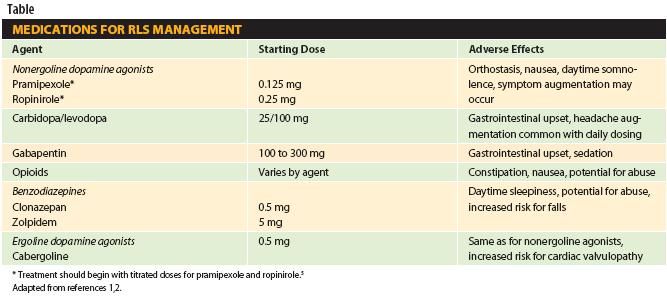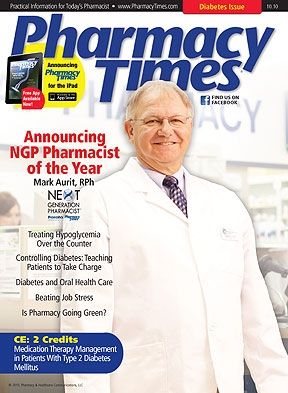Publication
Article
Pharmacy Times
Restless Legs Syndrome: Finding Relief
Patients with restless legs syndrome often experience symptoms for years before receiving an accurate diagnosis. Pharmacists are in a unique position to probe patients for this condition which negatively impacts health and quality of life.
Patients with restless legs syndrome often experience symptoms for years before receiving an accurate diagnosis. Pharmacists are in a unique position to probe patients for this condition which negatively impacts health and quality of life.
Restless legs syndrome (RLS) is a neurologic disorder affecting up to 10% of the population, with a female to male ratio of 2 to 1.1,2 Patients often describe uncomfortable sensations in the legs as burning, pins and needles, electric shocks, itching, “things crawling under the skin,” “soda bubbling in the veins,” or throbbing. Some describe these sensations as being painful as well.
These sensations result in a strong urge to move because voluntary movement brings some relief. Although legs are mostly affected, arms may also be involved. Symptoms are quiescegenic (occurring only during resting) and usually bilateral.3,4 Although periodic limb movement is common in RLS patients, an important distinction exists—periodic limb movement is involuntary, whereas RLS patients move limbs voluntarily to relieve sensations.
An RLS diagnosis requires the presence of 4 criteria:
• Urge to move legs because of unpleasant sensations.
• Symptoms begin or worsen exclusively during rest.
• Movement brings full or partial relief.
• Discomfort and subsequent motor activity are greater in the evening and at night.2
In the absence of all 4 criteria, a probable RLS diagnosis may be made if supporting criteria are present: family history of RLS; a positive response to dopaminergic agents; presence of periodic limb movements (up to 80% of RLS patients experience periodic limb movments2); and the presence of features strongly associated with RLS, such as sleep disturbances and worsening of symptoms over time.
RLS erodes quality of life. Sleep difficulties and nocturnal awakenings, leading to daytime fatigue and the inability to concentrate are common consequences, as are depression and anxiety.4,5 One study, for example, identified depression or other affective diagnoses in 43.7% of men with RLS and 46.1% of women with RLS.6 Increased prevalence of hypertension and heart disease accompanies RLS, and RLS patients tend to have poorer overall health.4
Adult RLS prevalence is estimated at 7% to 10%. Onset usually occurs between ages 35 and 70, with symptoms worsening with age. Up to 40% of adult patients with severe symptoms experienced their first symptoms before age 20.1,7 RLS has a variable course, but tends to worsen with age.2 Peripheral neuropathy and radiculopathy accompany late onset.7 Environmental triggers include caffeine, nicotine, lack of exercise, stress, and anxiety.8 Some studies report an association with alcohol intake.3,4
Additionally, antihistamines, H2- receptor antagonists, nausea drugs, lithium, anticonvulsants, selective serotonin reuptake inhibitors, and tricyclic medications tend to exacerbate RLS symptoms.3,8 Withdrawal from vasodilators, sedatives, or imipramine is also associated with RLS.9 If an RLS patient needs antidepressant therapy, prescribers should consider bupropion.2
Etiology
RLS is a central neurologic disorder, but its pathogenesis remains unclear. A strong genetic link exists, with 5 chromosomes implicated; between 50% and 70% of victims have a first-degree relative with RLS.1,3,4 Primary RLS, which is generally idiopathic, involves the central nervous system. The dopaminergic pathways’ role is well documented, demonstrated by RLS symptom resolution with dopaminergic agonists and symptom exacerbation with dopamine antagonists.3
Secondary RLS links RLS to an underlying pathology. Peripheral neuropathy and iron deficiency are the most common secondary causes.9 An inverse relationship exists between iron stores and RLS symptom severity. 10 Dopamine and iron vary with the circadian cycle, reaching nadirs when RLS symptoms peak. Because dopamine synthesis requires iron, clinicians should routinely assess serum ferritin levels and iron percent saturation in RLS.7 Other secondary causes include renal failure (up to 50% of patients experience RLS),1 diabetes, rheumatoid arthritis, fibromyalgia, vitamin deficiency (eg, folate, B12), hypothyroidism, and pregnancy.4 Up to 40% of pregnant women, for example, report RLS during their last trimester.9 Often, treatment of the underlying condition resolves RLS.
RLS is frequently misdiagnosed and most patients are only accurately diagnosed 10 to 20 years after symptom onset.1,9 RLS assessment should rule out secondary causes and mimicking conditions, especially nighttime cramps and periodic limb movement disorders. Other conditions with leg discomfort include arterial and venous insufficiencies, myopathies, small fiber neuropathies, arthritis, neuroleptic-induced akathisia, and positional discomfort or ischemia.10
Treatment
Symptom frequency (intermittent RLS with occurrence 2 to 3 times weekly, daily RLS) and severity (mild, moderate, refractory) dictate treatment. While treatment for secondary RLS focuses on underlying etiology, treatment for RLS relief is the same for all patients.
Levodopa is effective in the short term, but its therapeutic effects are confined to the first 4 to 6 hours in bed.10 Studies reveal that up to 82% of patients experience symptom augmentation with daily levodopa use and/or doses greater than 200 mg daily.11 Augmentation is an iatrogenic worsening of RLS with decreased responsiveness to the medication, accompanied by earlier daily symptom onset and symptom progression to previously uninvolved areas. Augmentation may occur soon after therapy begins or may take months or years to appear.12 Augmentation resolves with medication cessation.11
Because of augmentation, dopamine agonists are preferred as first-line agents, but augmentation still occurs in 10% to 35% of treated patients.4 Dopaminergic agents include ergoline derivatives (cabergoline) and nonergoline dopamine agonists (pramipexole, ropinirole).10 Ropinirole and pramipexole are the only FDA-approved agents for RLS. Because ergot-related dopamine agonists have been linked to fibrotic and cardiac valvular problems, nonergoline agonists are preferred even though RLS is an offlabel use.13,14 Dopamine agonists should be titrated upward until symptom relief is achieved. Severe daytime sleepiness has been reported in Parkinson’s disease patients on dopamine agonists.10
Second-line agents include the use of opioids (oxycodone, codeine) for relief when first-line agents are ineffective. Benzodiazepines may be used for their sedative effects for sleep deprivation. Oral iron is recommended for patients with serum ferritin levels <45 to 50 μg/L.3 Consensus is lacking for refractory RLS treatment, but consideration may be given to changing dopamine agonists, switching to an opioid or anticonvulsant, and adding a second medication, possibly with a reduced agonist dose (see Table).3,4

Along with pharmacotherapy, nonpharmacologic interventions may be helpful, and include:
• Eliminating or reducing agents known to precipitate RLS (eg, dopamine-blocking agents, antidepressants, antihistamines, caffeine, alcohol, and nicotine).
• Improving sleep hygiene (eg, regular sleep and wake times, warm baths before bedtime).
• Mild to moderate exercise.
• Some patients report improvement with vitamin E, folate, and magnesium, although scientific evidence is lacking.4,12,15
Final Thought
Patients often fail to mention their symptoms and most providers fail to query for RLS symptoms. If untreated, RLS negatively impacts health and quality of life. When patients complain about sleep disturbances or periodic limb movements, pharmacists have the unique opportunity to probe for RLS.
Dr. Zanni is a psychologist and health systems consultant based in Alexandria, Virginia. Ms. Wick is a senior research pharmacist at the National Cancer Institute, National Institutes of Health in Bethesda, Maryland.
References
- Bozorg A. Restless legs syndrome. Available at: http://emedicine.medscape.com/article/1188327-overview. Accessed July 31, 2010.
- Bayard M, Avonda T, Wadzinski J. Restless legs syndrome. Am Fam Physician. 2008;78:(2)235-240.
- Chahine LM, Chemali ZN. Restless legs syndrome: a review. CNS Spectr. 2006;11(7):511-520.
- HeningWA. The diagnosis and management of restless legs syndrome. Available at: www.medscape.com/viewprogram/5101. Accessed October 24, 2006.
- Zarcone VP Jr. Sleep hygiene. In: Kryger MH, Roth T, Dement WC, eds. Principles and Practice of Sleep Medicine. 3rd ed. Philadelphia, PA: WB Saunders; 2000:657-661.
- Banno K, Delaive K, Walld R, Kryger MH. Restless legs syndrome in 218 patients: associated disorders. Sleep Med. 2000;1(3):221-229.
- Allen RP, Picchietti D, Hening WA, et al. Restless legs syndrome: diagnostic criteria, special considerations, and epidemiology. A report from the restless legs syndrome diagnosis and epidemiology workshop at the National Institutes of Health. Sleep Med. 2003;4(2):101-119.
- Restless Legs Syndrome Foundation. Triggers for restless legs syndrome. Available at http://www.rls.org/Document.Doc?id=1870. Accessed July 31, 2010.
- Latorre J. Restless legs syndrome. Available at: www.emedicinehealth.com/restless_legs_syndrome/page16_em.htm. Accessed July 31, 2010.
- HeningWA, Allen RP, Earley CJ, Picchietti DL, Silber MH. Restless Legs Syndrome Task Force of the Standards of Practice Committee of the American Academy of Sleep Medicine. An update on the dopaminergic treatment of restless legs syndrome and periodic limb movement disorder. Sleep. 2004;27(3):560-583.
- Allen RP, Earley CJ. Augmentation of the restless legs syndrome with carbidopa/levodopa. Sleep. 1996;19(3):205-213.
- Restless legs syndrome: detection and management in primary care. National Heart, Lung, and Blood Institute Working Group on Restless Legs Syndrome. Am Fam Physician. 2000;62:108-114.
- Shaunak S, Wilkins A, Pilling JB, Dick DJ. Pericardial, retroperitoneal, and pleural fibrosis induced by pergolide. J Neurol Neurosurg Psychiatry. 1999;66(1):79-81.
- Horvath J, Fross RD, Kleiner-Fisman G, et al. Severe multivalvular heart disease: a new complication of the ergot derivative dopamine agonists. Mov Disord. 2004;19(6):656-662.
- Restless Legs Syndrome Foundation. Restless legs syndrome: diagnosis and treatment in primary care. Available at: www.rls.org/Document.Doc?&id=1296. Accessed July 31, 2010.







